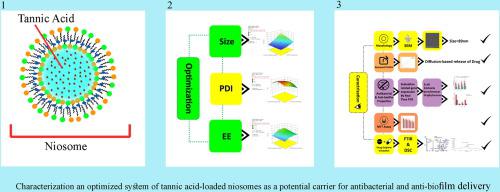Advanced Powder Technology ( IF 4.2 ) Pub Date : 2020-11-24 , DOI: 10.1016/j.apt.2020.11.008 Fatemeh Heidari , Iman Akbarzadeh , Dariush Nourouzian , Amir Mirzaie , Haleh Bakhshandeh

|
The purpose of this study was to prepare and characterize an optimized system of tannic acid-loaded niosomes as a potential carrier for antibacterial and anti-biofilm delivery. The niosomal formulation was optimized using response surface methodology (RSM). The effects of the molar ratio of surfactant to cholesterol, drug concentration, and molar ratio of Span 60 to Tween 60 on particle size and drug entrapment efficiency of the niosomal nanocarrier were studied. The optimized nanoparticles were characterized in terms of the morphology, in vitro release profile, and antibacterial properties. Moreover, Fourier-transform infrared spectroscopy (FTIR) and differential scanning calorimetry (DSC) techniques were utilized to investigate drug-excipient interactions. Antibacterial and anti-biofilm activities of free tannic acid and tannic acid-loaded niosome were investigated against selected pathogenic bacteria including Escherichia coli, Klebsiella pneumoniae, Pseudomonas aeruginosa, and Staphylococcus aureus. Furthermore, the expression level of biofilm-associated genes was evaluated in selected pathogenic bacteria using Real-Time PCR. According to the results, the dependent variables (particle size and entrapment efficiency) were best fitted to the quadratic model. The particle size and entrapment efficiency of the best niosomal formulation were 89 nm and 82%, respectively. The in vitro release of the optimized formulation showed a controlled release profile. Release kinetics indicated a diffusion-based release of the drug. FTIR and DSC studies also confirmed the absence of drug-excipient interactions. The optimized formulation exhibited higher antibacterial effects as compared with the free drug solution. Moreover, the time-kill assay of the encapsulated drug revealed a slow and controlled inhibition of bacterial growth for 72 h while the free drug was used up in the first hours. Moreover, tannic acid-loaded niosome reduced biofilm formation capacity in selected strains and down-regulated the biofilm gene expression as compared to free tannic acid.
The optimized formulation containing tannic acid can be a promising candidate for designing a new delivery system for this antibacterial and anti-biofilm agent.
中文翻译:

单宁酸负载的脂质体的优化和表征,以增强抗菌和生物膜活性
这项研究的目的是准备和表征单宁酸负载的脂质体的优化系统,作为抗菌和抗生物膜传递的潜在载体。使用响应表面方法(RSM)优化了脂质体配方。研究了表面活性剂与胆固醇的摩尔比,药物浓度以及Span 60与Tween 60的摩尔比对纳米级纳米载体的粒径和包封效率的影响。优化后的纳米颗粒在体外进行了形态表征释放特性和抗菌特性。此外,傅里叶变换红外光谱(FTIR)和差示扫描量热法(DSC)技术被用来研究药物-赋形剂的相互作用。研究了单宁酸和负载单宁酸的脂质体对选定病原菌的抗菌和抗生物膜活性,这些病原菌包括大肠杆菌,肺炎克雷伯菌,铜绿假单胞菌和金黄色葡萄球菌。。此外,使用实时PCR在选定的病原细菌中评估了生物膜相关基因的表达水平。根据结果,因变量(粒径和截留效率)最适合二次模型。最佳纳米配方的粒径和包封率分别为89 nm和82%。在体外优化制剂的释放显示出控制释放曲线。释放动力学表明药物基于扩散的释放。FTIR和DSC研究也证实了不存在药物-赋形剂相互作用。与游离药物溶液相比,优化的制剂表现出更高的抗菌作用。此外,对包封药物的时间杀灭试验显示,细菌生长缓慢且受控地抑制了72小时,而游离药物在最初的几个小时内就用完了。此外,与单宁酸相比,单宁酸负载的脂质体降低了所选菌株中生物膜的形成能力,并下调了生物膜基因的表达。
含有单宁酸的优化配方可以为该抗菌和抗生物膜剂设计新的递送系统提供有希望的候选者。









































 京公网安备 11010802027423号
京公网安备 11010802027423号